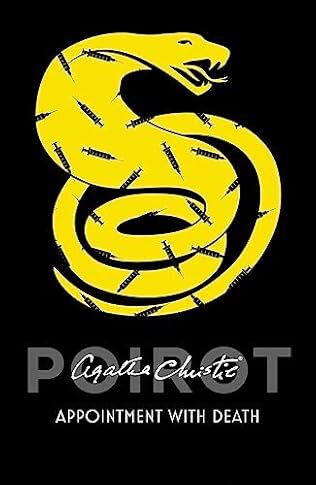Appointment With Death

A review of Appointment with Death by Agatha Christie – 241030
Originally published in 1938 and the nineteenth in her Hercule Poirot series, Appointment with Death has all the hallmarks of a classic Christie tale. The victim is an extremely unlikeable woman, Mrs Boynton, who takes delight in ruling her family with a rod of iron and suppressing their freedom and individuality, a death which could have passed as accidental but for the suspicions of a doctor, Dr Gerard, who spotted a puncture mark on her wrist, family members each of whom had reason enough and opportunity to kill their mother, and a glorious twist in the story’s tail.
The story starts in Jerusalem where purely by chance Poirot overhears Richard Boynton telling his sister, “You do see, don’t you, that she’s got to be killed?” The action then moves to Petra where, to everyone’s surprise, completely out of the blue Mrs Boynton gives her family permission to leave her and do what they want. During the course of the afternoon, she dies. As she is a woman with health problems, was the death natural or murder?
Poirot is called in by Colonel Carbury and flamboyantly boasts that he will get to the bottom of the mystery within twenty-four hours simply by interviewing the members of the party who were at Petra that day. Although he has no definitive way of knowing that it was murder, his little grey cells tell him that it is. During the course of his investigations, he constructs a timetable showing the movements of the Boynton family and when they claimed to have last seen Mrs Boynton alive. His analysis shows that their stories contradict that of Sarah King, a newly qualified doctor who places the time of death as being earlier than the last supposed sighting of the victim alive. Were the Boynton’s covering up for each other?
The mystery of a hypodermic needle – there are three all told – the use of digitoxin, a drug that Mrs Boynton already took for medicinal purposes, and the sight of an altercation between a Bedouin servant and the victim coupled with a remark that she made in the direction of Sarah King before the party set out to Petra gives Poirot a different perspective of what happened. In classic Poirot style he convenes a meeting of all the suspects, lays out reasons why each of the family could have been the murderer and the reasons why the were innocent, before dramatically revealing who really was the murderer and why. Instead of a story of a family trying to break out from the shackles imposed upon them by a cruel mother, it is one of blackmail and revenge.
The story is well told in Christie’s usual bright and breezy style, which holds the reader’s attention without ever overtaxing them. Poirot is his usual bumptious self and Colonel Carbury, an Englishman to his very core, bristles at his lack of modesty. Nevertheless, as we always knew he would be, Poirot is as good as his word, unmasking the true culprit within the allotted time. The ending is a little too sentimental for my taste with each of the Boynton family finding in their own way the happiness that they had long been denied. The killer, meanwhile, a wonderful character in their own right and for whom this reader had more than a little sympathy, takes their own life.
This is one of the better Poirot stories and thoroughly enjoyable it is too.



